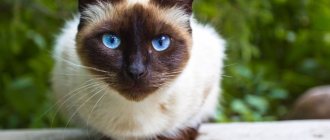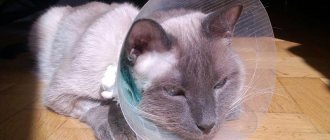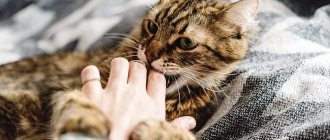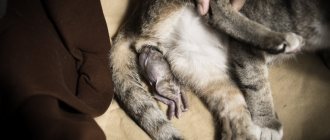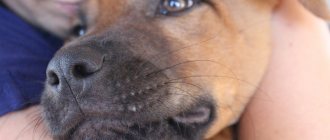From this material you will learn why a cat needs a mustache. About what function they perform and why they are important for a cat. We'll tell you why whiskers shouldn't be cut and whether cats have problems with them.
Cats have lived side by side with humans for many centuries. It would seem that we know everything about these pets. But cats are very complex creatures by nature. You can talk about their features for a very long time, but today we will focus on the topic: what kind of mustache does a cat have? We have no doubt that many interesting discoveries await you.
Whiskers are not only a cat’s pride, but also an essential organ for him.
Scientific name for mustache
Few people know that cat whiskers have several different names. There is an interesting fact: cat whiskers are located not only on the animal’s face, but also on the paws, eyebrows and chin.
There are several options for the names of hairs on a cat’s face:
- mustache;
- vibrissae;
- tactile hairs.
Cat whiskers have their own scientific name - vibrissae. Which in Latin means: “to fluctuate, to vibrate.” Indeed, cats' whiskers spend a lot of time in motion.
In Russian, this name is read as “vibrissae,” and it is also used in Russian scientific literature, where there is a description of cats’ whiskers.
Cat whiskers also have a second scientific name - “tactile hairs”. It was also not given to these hairs by chance. The fact is that in cats, whiskers occupy an important place among the senses, or, more specifically, touch. They help animals move smoothly, navigate in space, hunt, and also act as a kind of indicator in communication with people; you can also understand the cat’s mood by the whiskers.
Many people mistakenly believe that cat whiskers are just regular hairs, which is why they are called that. But this definition is not entirely correct. Vibrissae are not simple hairs on the body of an animal. Although they are similar in nature to hair, vibrissae are dead formations whose roots lead to blood vessels.
What are vibrissae
Cat whiskers (scientifically called vibrissae) are hard and thick whitish hairs. In cats, this is the organ of touch. They grow in groups: the longest ones are located above the upper lip, they are the most sensitive. Under the eyes, on the chin, in the cheek area they are shorter and less sensitive. Vibrissae are also scattered throughout the body and are present on the ankles and pads of the paws.
Thanks to the whiskers, the cat has the ability to navigate in space, perceive changes in air humidity and changes in atmospheric pressure. Even if she is in a dark room, she perfectly understands her location. A completely blind animal with developed and preserved whiskers exists comfortably in its environment.
The fact is that from the vibrissae, equipped with blood, nerve endings go directly to the trigeminal nerve. It is for this reason that the organ of touch is triggered even by a slight vibration in the air and sends a danger signal to the brain, and the brain, in turn, draws a three-dimensional picture of the surrounding world.
Acquaintance with a new object or person for cats always begins with feeling and sniffing. At this moment the animal looks very funny: the mustache moves forward, puffs up, the nostrils move. This way it collects as much information as possible about an unfamiliar object.
To understand the principle of action of the whiskers, just touch the tip of the cat’s nose with your finger - she will instinctively close her eyes. This happens because the animal is afraid of harming itself - the self-preservation reflex is triggered.
Mother Nature endowed cats with this wealth so that they could protect themselves from various obstacles when hunting in the dark (bushes, branches, grass), crawl through narrow cracks, using vibrissae to estimate the area of the opening, measure the speed and direction of the wind, which affects the direction and strength jump.
Vibrissae, in addition to performing protective functions, are an indicator of the animal’s mood. An aggressive cat tries to press its whiskers to its muzzle, while a friendly and affectionate pet has its whiskers directed forward.
Cats are smart and graceful pets. They quickly learn and adapt to new conditions, do not require special care, and are friendly and tactful. Cats subtly sense the mood of their owners and even know how to change it. Therefore, having settled in a person’s house, they conquer his heart forever. The owner is ready to do a lot to ensure that the cat is happy with life. To maintain good health of your pet, you need to know its physiology at least in general terms. This information will help you properly organize food and care for your animal. It will also be useful to understand why a cat needs a mustache.
Features of the structure of whiskers in cats
There is no difference between the structure of the whiskers in males and female cats. This organ performs the same function. The length and thickness of the vibrissae may differ not so much between cats and cats, but among representatives of different breeds.
Take a closer look at your cat's paws. You will notice vibrissae on them
The mustache is located:
- on the muzzle;
- above the eyebrows;
- on the chin;
- on the front legs.
The length of the whiskers on the cat's face is approximately 5–7 cm. The owners of the longest whiskers are Maine Coons. Large cats have long whiskers. In sphinxes, on the contrary, the vibrissae are very short and often curled. The thickness of the whiskers is greater in cats; the whiskers in cats are more graceful.
The healthy appearance and length of the whiskers is influenced by the cat's diet. If your pet eats a balanced diet and is healthy, then the mustache will be luxurious.
The cat's whiskers themselves are an unusual organ. Each hair has a connection with a specific part of the brain and is responsible for only one function. Therefore, if a cat loses one of its antennae, it temporarily experiences problems in coordination or touch.
How are vibrissae arranged?
Vibrissae are long, coarse hairs that protrude beyond the coat. Each hair originates from a hair follicle surrounded by nerve endings. This organ of touch is mobile, which is ensured by contraction of the striated muscles.
Any, even slight, environmental impact is transmitted to its root and irritates the cells of the nerve endings. The received information is transmitted to the brain and analyzed by the animal.
Each individual has its own area in the sensory region of the brain. The overall picture of the environment is made up of incoming visual and tactile information. At night, the sense of touch has advantages, since it does not depend on external factors.
Vibrissae help determine the distance to an object standing in the way. In the dark, the animal easily bypasses obstacles and rushes at the prey with precision.
Cats clearly know the distance to an object when jumping
This is explained by the fact that objects reflect vibrations and air masses, which are captured by sensitive vibrissae.
It is believed that those located on the sides of the muzzle determine the diameter of the hole into which it is trying to climb. If the animal is overly fat, there is a possibility of getting stuck.
When hunting, a cat relies not only on sight and hearing, but also on touch.
With the help of its whiskers, the animal determines the direction of the wind and searches for a suitable smell.
As a rule, when hunting, a cat moves against the wind to hide its scent and have control over the prey.
Moving ones signal the cat’s mood. A friendly animal spreads its whiskers to the sides and forward, which also shows interest. An aggressive attitude causes the animal to press its whiskers to its head. The vibrissae of an animal at rest are motionless.
If you touch a cat's whiskers while she is sleeping, she will react and open her eyes.
Vibrissae warn the owner of possible danger. Touching branches, grass and walls, they cause a reflex to close an eye or duck. This protects the cat from possible mechanical damage.
In case of hearing or vision loss, the mustache becomes the main source of information.
Even minor changes in the surrounding space will not go unnoticed by the cat.
The main purposes of a cat's whiskers
Cat owners need to remember that the whiskers are a separate sensory organ for your pet, which not only helps them navigate the area, but also communicate both with people and with each other. And this body performs several functions:
Mustache as an organ of touch
Whiskers are a cat's sense of smell. With the help of its whiskers, a cat determines the freshness and quality of food and water.
Navigation task
Everyone knows that cats can move silently in complete silence and darkness. It turns out that she can do this only thanks to the vibrissae.
Vibrissae are incredibly sensitive. They capture air currents that are reflected from objects standing nearby. This is what helps the cat determine the location of objects and avoid obstacles even in complete darkness. Nerve impulses from the vibrissa enter the animal’s brain in the same way as from the eyes. The brain adds signals received from the eyes and vibrissa and creates a three-dimensional picture of the environment.
Protective function
If you touch the whiskers, the cat will close its eyes. When hunting, this is a very important reflex for a predator, which sneaks up on prey without taking its eyes off it and at the same time overcomes obstacles: bushes, fences, or crawls into narrow holes. When hunting, the cat's whiskers are extended forward, with their help it catches the slightest rustle.
Whiskers for hunting
Whiskers help a cat hunt. With the help of whiskers, the cat easily determines the location of the victim, the direction of its movement, as well as its condition. When prey is caught and the cat does not see it because it is held in its teeth, the whiskers help control how the prey behaves.
Vibrissae also help the cat during hunting.
Mustache as an aid in communication
When communicating with your cat, you should pay attention to the position of its whiskers; they will tell you what mood your pet is in.
- If the presence of a person arouses interest in the animal, then the cat's whiskers will be directed forward. This is a hint that the cat is interested in you and is studying you.
- If an animal has pressed its whiskers together with its ears, then such a cat should not be stroked. She is scared or aggressive.
Vibrissae on a cat's body help it determine how someone touched the cat and whether this contact was pleasant. When you stroke a cat's fur, the cat finds this contact pleasant. But if you stroke the cat against the grain, this will irritate the whiskers. And such contact will be unpleasant for the cat.
Why do cats and cats need whiskers?
It is clear that whiskers are not just hair on a pet’s body. They play an important role in the life of a furry individual.
Help in hunting
In ancient times it was believed that the length of the whiskers indicated hunting habits. The longer the hairs on the face, the better the cat catches rats and mice.
This fact has no scientific confirmation. But it is obvious that thick shoots are the pet’s main assistants during the hunt. Thanks to them, cats quickly pick up even small vibrations in the air that are created by a running rodent.
The furry hunter easily determines where the prey is and where it is moving. After the rodent is caught, the cat's antennae on its front legs help it retain its prey and control its behavior.
Orientation in space
Fluffy purrs are well known for their ability to move silently and deftly even in complete darkness. At such moments, it is not the eyes or ears that help the animal. The cat uses its whiskers to touch objects and avoid obstacles.
When touching surrounding things, the hairs vibrate, creating air movements. These signals are picked up by the whiskers and transmitted to a specific part of the brain. This is how the pet forms a three-dimensional picture of what surrounds it.
Tactile function
Touch is the main purpose of vibrissae. They help the fluffy one accurately determine the freshness of food and the safety of products. Before starting to eat, the cat will feel the food with its whiskers (sniffing movement) and only then begin to eat.
Signals in communication
It is easy to understand why a cat needs a mustache in those moments when the animal wants to communicate. If you look closely at your furry friend, you will notice the movement of the antennae. The vibrissae change direction in relation to the person or object of interest to the cat.
Whiskers pointed forward indicate the purr's desire to explore an object or desire to communicate with a living creature. Animals also collect antennae while playing or hunting.
Causes of mustache loss
If you notice a cat's whiskers falling out, there is no need to panic. This is normal: old mustaches die off and new ones grow in their place. But if the pet suddenly began to lose whiskers, and new ones never appeared, this indicates a serious malfunction in the body.
Lack of vitamins in the body
Vibrissae begin to fall out when the cat’s diet lacks vitamins A, D, collagen and taurine, and certain microelements. With a lack of these beneficial substances, the disease can be accompanied not only by loss of whiskers, but also by hair, bad breath, and poor condition of the claws.
In this case, you need to contact a veterinarian and undergo the necessary tests to determine which vitamin is missing. Then it will be enough to change the diet and add foods rich in the vitamins the cat needs.
Lightened and falling out whiskers may indicate the presence of worms in the animal.
Thyroid problems
Disturbances in the functioning of the thyroid gland, deficiency or excess of its hormones also lead to loss of mustache. These problems are most common in older cats.
Additional symptoms are diarrhea and vomiting, constipation. If these signs are present, you should immediately contact a specialist who will prescribe a course of treatment. Self-medication will only worsen your pet's condition.
Skin diseases
Bacterial and infectious diseases can cause itching and irritation in your cat. The reason for this may be injuries, scratches, cuts.
Severe itching, weakness and loss of appetite appear.
Allergy
Due to food allergies, cats may experience hair and whisker loss. To stop this, you need to find out what product is causing your pet’s allergy and eliminate it from the diet.
If your cat has problems with its whiskers, pay attention to:
- Air humidity in a house or apartment;
- Availability of a bowl of water. Mustaches can fall out due to dehydration;
- Quality of animal feed. It must contain natural ingredients, be balanced and not have harmful additives;
- Bathing mode. It is enough to wash the cat once every 3 months;
- Hairless breeds require frequent bathing - once every two weeks in the spring and every month in the winter. The cause of mustache loss can also be the wrong shampoo;
- Time of year and puberty.
If you do not fight the loss of whiskers, this will lead to the pet becoming confused, fearful, and unable to navigate the area, even if it is an apartment in which he has lived his whole life. And on the street such a cat has a negligible chance of survival.
Consequences of loss
The consequences of trimming cats' whiskers can be very varied and depend on whether the animal is a pet or an outdoor one, as well as on individual characteristics. The most difficult situation for the lack of their sensory sensors is street cats who are forced to get their food in the wild. Without whiskers, it will be difficult for backyard predators to track their prey and hunt successfully.
What happens if a cat's whiskers are trimmed depends on the individual sensitivity of a particular pet.
At first, some animals may lose the ability to navigate normally in the surrounding space.
There are cases where cats deprived of whiskers could not walk in a straight line for a certain time, fell and lost orientation in space. This failure in the animal’s navigation system is due to a sharp lack of signals about the environment entering the brain.
Of course, such extreme manifestations are not typical for all animals. Most often, the loss of whiskers leads to the fact that it is more difficult for a pet to make accurate jumps and navigate in the dark. Without whiskers, a cat more often stumbles upon obstacles and does not navigate in an unfamiliar environment.
Owners often ask experienced breeders what will happen if their cat's whiskers are trimmed. Without tactile sensors, domestic cats, of course, can do without any consequences for their health and life. Living in comfortable conditions, furry pets do not experience the loss of sensory organs so acutely.
Veterinary experts under no circumstances advise owners to trim or trim their animal's whiskers. Such manipulation can lead to stress, fearfulness, and inappropriate behavior. Some especially sensitive pets have a hard time coping with the loss of their whiskers: they become withdrawn and become non-communicative. Cats sleep for a long time and stop leading an active lifestyle.
To see what happens if you cut a cat's whiskers, watch this video:
Life without a mustache
Cats are very curious animals. They can watch a lit candle or stove. Investigating these phenomena can damage the mustache. Sometimes children play with cats and trim their whiskers. If this happens, the cat becomes completely helpless. It is difficult for her to navigate in space, she becomes simply unhappy.
Sometimes, due to its curiosity, a cat may be left without a whisker.
How does the loss of a whisker affect the health and behavior of a pet?
The most common are a sharp loss of the ability to move normally, navigate in the dark and in space, adequately assess the size of objects, the distances to them and between them. The accuracy of jumps and adaptability to new environments also decrease. The cat’s overall activity decreases, he becomes less playful, withdrawn, and sometimes even aggressively fearful. You need to give your pet time to get used to the new circumstances and wait until the mustache grows back. If the whiskers do not recover after a month, then it is better to seek help from a veterinarian.
Beautiful, luxurious whiskers are the pride of any cat, but they are not needed for decoration. It used to be said in villages that the bigger a cat's whiskers, the better it is at catching mice. This statement is partly true, because tufts of long hair, which are commonly called mustaches and eyebrows, really help the animal to hunt, but their function is not limited to this. Why does a cat need a mustache? What are they called scientifically? What happens if you cut them off? Why do my mustaches fall out?
Problems with whiskers in cats and kittens
Mustaches have their own lifespan. The cause of excessive mustache loss and breakage can be both physiological and pathological. Various bacterial and fungal infections, as well as injuries, must be treated promptly to avoid complications.
The role of whiskers in the life of a cat is very great. They are not only the pride and decoration of the cat. This is a full-fledged sensory organ, it is the cat’s “navigation system”. With the help of its whiskers, a cat processes information about the world around it.
Features of a cat's whiskers
Cat whiskers are scientifically called vibrissae. This concept comes from the Latin word “vibrissae”, which can be translated as “vibrate”, “wriggle”, “oscillate”. Indeed, the hairs of the mustache are in constant motion and vibrate. In their structure, the vibrissae resemble ordinary hair, but, in essence, they are sensory organs. They are also called “tactile hairs”. Compared to regular wool, they are much stiffer, thicker, longer and rooted deeper.
Tactile hair has deeper roots than normal hair
Structure and location
The root of the cat's whiskers is located in tissues with many nerve endings that go directly to the vibrissa hair bursa. There is a special area in the animal's brain for each antennae. Therefore, any changes in the environment, be it air vibrations or the appearance and movement of some objects, are directly transmitted to the brain and affect the cat’s behavior.
Vibrissae roots lead to nerve endings and blood vessels
The bulk of the whiskers are located on the animal's muzzle: there are four horizontal rows on both sides of the nose, the average number of whiskers being 24 pieces. The length of one vibrissae is approximately 6–7 cm, but, depending on the breed and individual characteristics of the animal, this figure can vary either up or down.
The longest mustache listed in the Guinness Book of Records was a Maine Coon cat Missy from Finland - as much as 19 centimeters. Representatives of this breed are generally characterized by prominent mustaches. As for ordinary outbred cats with long mustaches, they have always been considered by the people to be the best hunters of mice and rats.
Vibrissae are located not only on the cat’s cheeks, but also above the eyes, on the chin, and even on the paws and tail. These shorter antennae still perform the same tactile function. For example, vibrissae on the paw pads allow the animal to feel the vibration of the floor.
There are also short whiskers located between the pads on the cat's paw.
The whiskers on the forehead, which people mistake for eyebrows, help not only to sense space, but also to protect the most important organ of the animal - the eyes.
Interestingly, the length of the whiskers depends on the thickness of its owner - fat cats always have longer whiskers than thin ones.
Why are vibrissae needed?
Thus, the main vibrissae on the cheeks and additional ones in other places help the cat:
- Navigate by air movements in space, including assessing the appearance and size of surrounding objects, the distance to them, the correspondence of the parameters of the holes into which you want to crawl to the size of your body. Whiskers become especially good helpers in the dark, when the animal’s vision fails. Cats see without light better than people, but still not well enough for full-fledged hunting or active pastime.
- Hunt, because with the help of whiskers you can assess the direction and strength of the wind for jumping, climbing trees, and also control the behavior of the caught prey, which the cat carries in its teeth.
- Express your emotions and mood: in an interested cat, ready for action, the whiskers are widely spaced and slightly tilted forward, while in a frightened or angry cat, they are pressed tightly to the muzzle.
Vibrissae inform the cat whether the prey is still alive and whether it is trying to resist
Is it possible to trim a cat's whiskers?
Vibrissae are renewed in the same way as ordinary hairs: they age, die, fall out, and new ones grow in their place. This process occurs throughout the cat’s life, including in old age. By tracking age-related changes in an animal's whiskers, you can notice that they become thicker, acquire a dark color, and turn gray in old age. The fallen whisker is usually partially colored, quite stiff and has a sharp end. With age, the rate of replacement of old vibrissae with new ones decreases.
The question of whether it is possible to cut whiskers is often of interest to those who, in addition to cats, have active children who use cats as entertainment. Children can cut off the animal's whiskers while playing. The answer is simple and clear - you don’t need to do this! For cats, whiskers are not a decoration, but a means of touch. There is no need to deprive animals of an additional sense organ. The cut whiskers will gradually grow back, but the cat will feel unwell during the “whiskerless” period.
Whiskers are very sensitive, cats can hardly tolerate being touched by humans or other animals.
However, when conducting research, scientists did not spare the poor animals and repeatedly cut off their whiskers, and then observed changes in behavior. Much depends on the character of the cat: some were very lost and scared, while others behaved almost normally. However, all cats had the following problems:
- they began to navigate worse in the dark and bump into objects;
- could not correctly estimate the size of the holes to penetrate them and often got stuck;
- The accuracy of jumps decreased - they missed or did not reach the object they wanted to jump on.
Cats with cut whiskers lose the ability to correctly judge the distance to jump
Of course, nothing particularly terrible will happen to a domestic cat whose whiskers are cut off, because in an apartment it exists in comfortable conditions, and the whiskers will gradually grow back. But a street cat will have more problems, because its life often depends on the accuracy of orientation in space. In any case, you need to try to explain to children that a cat is a living creature, not a toy, and its whiskers cannot be touched without parental permission. As for adults, it is difficult to imagine a reason why they would want to trim a cat's whiskers. Even if there is a reason, it is better not to do this, but to go to an appointment with a veterinarian.
Any cat after cutting off its whiskers may become confused and behave inappropriately: become nervous, timid, clumsy, uncommunicative and passive.
However, there are exceptions to the general mass of mustachioed cats. These are some breeds whose whiskers are missing or look strange. Cats of the Donskoy, St. Petersburg, and Canadian Sphynx breeds often have no whiskers at all. At the same time, they behave absolutely normally, except that they are colder than the others, but that’s another story. Hybrid breeds, such as elves, greyhounds, and bambinos, have very short and sparse, sometimes curled whiskers. Finally, Cornish Rex and other "curly" breeds have whiskers of normal length, but curled into a spiral.
Sphynxes have no mustaches at all or only grow in small numbers.
Video: what happens if you cut a cat's whiskers
Solution
If a cat loses its whiskers, it is necessary to find out the reasons for this phenomenon. In case of mechanical damage, you should try to avoid such situations again. If the issue is poor nutrition, the veterinarian will recommend the optimal food. The problem may also be related to illness. It is necessary to show the cat to a specialist.
Due to the fact that the vibrissae help the pet navigate in space, when deprived of them, it can bump into objects and walk unsteadily in the dark. Therefore, until the whiskers grow back, it is recommended not to let the animal go outside and be extremely attentive to it. Fortunately, if everything is in order with your pet’s health, then the hairs will appear very quickly. The cat will feel confident.
Is it possible to cut off a cat's whiskers?
A common mistake is that a cat's whiskers should be trimmed at the owner's discretion. Some cats, like the Devon Rex, even have curly whiskers, so you might think it wouldn't hurt to straighten them with a little trim. This is absolutely forbidden to do!
Important! Trimming a cat's whiskers is a big mistake. Without tactile hairs, pets become disoriented and fearful.
Why do cats need whiskers?
Vibrissae allow them to assess the situation and analyze the environment. Whiskers do grow, but cats need to keep them intact just as humans need their sense of touch. Scientific experiments conducted by English scientists with cats with shortened whiskers may explain why whiskers are needed. Without them, it is difficult to judge the exact locations of objects in space. Pets often misjudge jumping distances and sometimes collide with things in the way.
A cat without a whisker feels confused
Unforeseen situation
Having figured out why a cat needs a mustache, the owners worry when they start to break off. This can happen for mechanical reasons when the cat leads an overly active lifestyle or gets into a fight. But other factors can also serve as reasons.
Vibrissae can break off due to poor quality nutrition. Calcium and other minerals especially affect their growth. If the whiskers are constantly breaking, you should reconsider the food and possibly change it.
Elasticity and strength can be affected by the presence of parasites. It is recommended to carry out preventive measures aimed at eliminating worms and fleas. If the situation has gone too far, then only a veterinarian can solve the problem.
If there are children in the house, then you need to explain to them why cats need whiskers and ask them not to deliberately break them off. Sometimes another animal, in order to show its superiority, can bully a cat and encroach on its useful decoration.
Important! Sphynx cats often lose their whiskers. If they are constantly updated and the cat looks healthy, then this is the norm, because such a situation is genetic.
